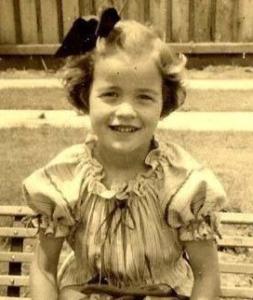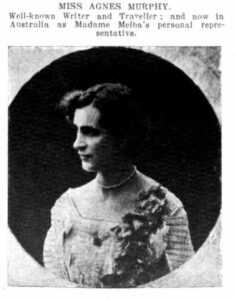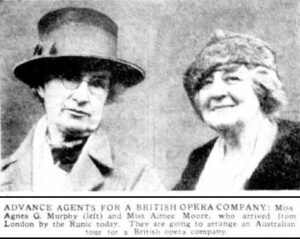by Teresa Pitt
 At the turn of the twentieth century there was a considerable cohort of independent single women, engaged in writing and in first wave feminism: Catherine Helen Spence, Rose Scott, Miles Franklin, Mary Fullerton, Vida Goldstein to name a few. To this list we must add Agnes Murphy.
At the turn of the twentieth century there was a considerable cohort of independent single women, engaged in writing and in first wave feminism: Catherine Helen Spence, Rose Scott, Miles Franklin, Mary Fullerton, Vida Goldstein to name a few. To this list we must add Agnes Murphy.
Agnes Gillian Murphy (1869-1931) was a pioneering and much-travelled female journalist, networker, music promoter and author who wrote the first-ever biography of Dame Nellie Melba. She was also a fierce Irish nationalist. And she was almost certainly a lesbian, although she never described herself as such.
I had never heard of Agnes Murphy until I saw a mention of her recently on Facebook by Lucy Sussex. I then discovered that Lucy had co-written an article about Agnes (with Meg Tasker) for Southerly back in September 2011, and I thank her for providing me with a copy.
 I also found a detailed account of Agnes’s life on the website of the East Melbourne Historical Society – she always lived in East Melbourne when she was in Australia – and this led me to further explorations at Trove and elsewhere. Here’s what I know so far.
I also found a detailed account of Agnes’s life on the website of the East Melbourne Historical Society – she always lived in East Melbourne when she was in Australia – and this led me to further explorations at Trove and elsewhere. Here’s what I know so far.
Lucy Sussex describes her as ‘an unconventional and remarkable woman’, and she was certainly quite the entrepreneur. It appears she was quite famous in her time.
Early years
She was born in County Offaly (formerly King’s County), Ireland, and arrived in Melbourne in 1884, aged fifteen, to visit her sister Elizabeth (Lily). Shortly after her arrival, she received news that her family’s Irish estate had been lost. A period of poverty ensued; the Adelaide Register later reported:
… the lady herself is not above confessing that at one time when she had no money for the cobbler, penny postcards placed inside her shoes did duty in the holes worn through the leather by her constant walking in search of a daily existence.
She eventually got a job on a new magazine called Table Talk.
She was then briefly the social editor at The Herald before starting a column, ‘A Lady’s Letter’, for the Melbourne Punch, writing under the byline ‘Rhoda’. In it she wrote chatty news to an imaginary friend called Esme, as well as social and fashion notes. She published this column for seven years.
In 1888, aged nineteen, she met Annie (‘Aimee’) Moore, a journalist and aspiring actress, who became her lifelong partner and constant companion. Aimee’s family had recently moved to Melbourne from Ballarat, but we don’t know exactly how they first met.
In 1890 Agnes and Aimee were among the early members of the Austral Salon, Melbourne’s first women’s club. Originally comprising the twelve female journalists then working in Melbourne, it was created ‘to support the intellectual advancement of the women of Australia’. The Salon’s membership included many of Melbourne’s female writers, musicians and artists, including singers Nellie Melba, Ada Crossley, Florence Austral, Marjorie Lawrence and Amy Castles, poet Ada Cambridge, and investigative journalist Catherine Hay Thomson.
Agnes had begun her spectacular social climb.
One Woman’s Wisdom
Around this time Agnes wrote her one and only novel, One Woman’s Wisdom, which was published by Routledge, London, in 1895.
A thinly disguised depiction of Melbourne society of the time, the novel’s heroine, Mary Hewson, is clearly based on Agnes herself. Mary expresses many of Agnes’s then-radical opinions on marriage and a woman’s right to an independent life.
According to Lucy Sussex,
Murphy’s One Woman’s Wisdom belonged to a genre, the ‘New Woman’ novel, the fictional expression of the move towards female suffrage and emancipation. It most resembled Miles Franklin’s My Brilliant Career in its liveliness, and its depiction of the marriage-versus-career dilemma for women … Its major interest is in the powerful portrayal of the heroine, an independent and unconventional woman who carves a professional career without marriage and children, in which her chief affection is same-sex.
The novel contains many descriptions of the charms and attractions of women. At one point Mary remarks,
… it must always be much more delightful to kiss the fresh, soft lips of a girl than the moustached mouth of a man.
The Pall Mall Gazette remarked of it:
… this novel contained the most perfect English written for that year.
Mr Hume Nisbet summed it up as
… a collection of exquisite mosaics of Irish and Australian characters.
Table Talk said of it, rather bitchily, that,
… if it does not disclose any literary ability, it serves to prove the truth of Sir Walter Scott’s dictum: ‘The common people are the severest critics of the conduct of their betters’.
Most critics apparently praised it highly, but two months later, Routledge wrote to its Melbourne agent requesting that the book be withdrawn from sale because of several pending libel suits.
(One Woman’s Wisdom is available as print-on-demand from various websites – I’m awaiting my copy from World of Books.)
To England
In 1895 Agnes and Aimee sailed to England together. There Agnes started a new column called ‘Rhoda’s Letter’ for the Melbourne Punch, where she reported on the social activities and theatrical successes of Australians living in London. Her networking paid off, and she was invited to all the best parties.
While in England, Agnes worked for several newspapers including the British Australasian, as well as being English correspondent for the local Australasian. At the time of the 1901 English Census, she was living in Montague Mansions, Marylebone, with Aimee and the Australian contralto Ada Crossley.
Table Talk’s reporter thought they were:
… an odd trio to be chums. Miss Crossley is distinguished for her elegance and beautiful frocking, Miss Murphy scorns such feminine fripperies and adheres to semi-masculine garb, with a sailor hat pressed down hard on her short-cropped, curly hair, whilst Miss Moore is of the etherials, aesthetic style, who patronises lank, clinging garments, and big, floppy ‘Potteresque’ hats.
Agnes befriended and supported many Australian female musicians seeking to make their mark internationally, including Amy Castles and Ada Crossley. The Critic regarded her as ‘the best-informed journalist in London on musical matters generally’.
Lucy Sussex writes:
This female-oriented networking, even across the hemispheres, was typical of Murphy—she might live in a patriarchal society, but she always sought out the matriarchs, offering her friendship and skills in exchange for their patronage. It was also typical that Murphy then repeated the story in the colonial press, showing her talent for public relations.
Acclaim in London
Agnes and Aimee returned to Australia in September 1903. The following report appeared in the Freeman’s Journal, Sydney, on 26 December 1903:
The day before leaving for Australia Miss Murphy was elected, along with John Oliver Hobbes and John Strange Winter, to the Council of the Society of Women Journalists in London. With great and natural pride Miss Murphy showed the beautifully designed and illuminated address, with green Morocco cover, with her initials in silver, which was presented to her on her departure by celebrated Anglo Australians in the London musical, art, and literary world. This address, which bore among the signatures the names of Mme. Melba, Miss Ada Crossley, Mine. Minna Fischer, Miss Marie Narelle, Mr. Percy Grainger, The Griffiths sisters, etc., etc., and was illuminated by Mr. Arthur Streeton, was accompanied with a gold purse containing 100 sovereigns, a silver toilet service, a gold pen, and a Byzantine pearl brooch.
On this occasion Miss Aimee Moore was presented with a lovely Venetian lace fichu and silver toilet bottles.
The officers of the King’s Colonials, out of gratitude for the magnificent success of the concert organized on their behalf by Miss Murphy, presented her with a handsome diamond and sapphire bangle also before she left for Australia. The King’s Colonials’ concert introduced Miss Marie Narelle’s name, of whom Miss Murphy spoke in most enthusiastic and glowing terms.
They spent a few months on tours in Australia and New Zealand before setting off again for America and Canada in early 1904. In Washington, at the International Geographical Congress, she was granted honorary membership of the Geographical Society of California, the first woman to receive this honour.
Nellie Melba
By November 1905 Agnes and Aimee were back in England, but the following year they returned to America as guests of their now-close friend Nellie Melba. Melba appointed Agnes as her private secretary and press agent in May 1907, and they accompanied her on her Australian tour in 1909.
During this period Agnes wrote the first book-length biography of the famous singer; Life of Melba was published by Chatto & Windus in 1909. According to the East Melbourne Historical Society, a specially bound copy was presented to Queen Alexandra. The book was well reviewed and remains an important reference work; parts of it were written by Melba herself.
In 1910 Agnes and Aimee went to Canada, where Agnes joined the staff of the Quinlan International Musical Agency, as Thomas Quinlan’s personal representative on the tour of the Quinlan Opera Co. in the United Kingdom, South Africa, and Australia. Aimee was described for the first time as ‘Miss Murphy’s secretary’.
Further travels
The pair arrived in Australia in April 1912 in preparation for the Australian leg of the tour, and were still here when war was declared in 1914. From 1914 to 1919 Agnes wrote many letters to newspapers about political issues of the day, including female suffrage, the Irish and the war, conscription and the need for Catholic hostels.
 Agnes and Aimee spent much of 1922 on tour around Australia with the Sistine Choir, but by 1923 they were back in Melbourne, before setting off for a tour with the Gertrude Elliott Company around Australia and New Zealand. In March 1924, in service of the same company, she and Aimee set sail for London, this time accompanied by Agnes’ sister, Lily. They stayed in Paris with Lalla Miranda, another successful Australian-born singer, and then went to New York in connection with the appearance of the Italian singer Amelita Galli-Curci at the Metropolitan Opera House.
Agnes and Aimee spent much of 1922 on tour around Australia with the Sistine Choir, but by 1923 they were back in Melbourne, before setting off for a tour with the Gertrude Elliott Company around Australia and New Zealand. In March 1924, in service of the same company, she and Aimee set sail for London, this time accompanied by Agnes’ sister, Lily. They stayed in Paris with Lalla Miranda, another successful Australian-born singer, and then went to New York in connection with the appearance of the Italian singer Amelita Galli-Curci at the Metropolitan Opera House.
Death
After a brief return to Melbourne, Agnes left for Europe in January 1930, again with Aimee and Lily. Just over a year later, on 15 March 1931, she died in England of a perforated ulcer, aged 62.
She was buried in the Hampstead Cemetery, London. Aimee and Lily then returned to Melbourne and took a flat together in Malvern. At this stage I have no information on their later lives or when they died.
In its obituary, the Melbourne Advocate (a Catholic paper) described her as:
… one of the first, and perhaps the most brilliant and versatile of press women that Australia has known. She was, in the truest sense, a cultured lady and her sane and extensive knowledge of art, music, [and] literature gave to her writings and conversation a poise and a body that were remarkable. With strong views on many matters, this quietly spoken, distinguished woman was a curious force on those who came within the field of her influence.
Was she a lesbian?
Romantic female-female ‘crushes’ were very common in the nineteenth century, and it’s difficult to tell whether they went any further than close sentimental friendships.
The term ‘lesbian’, meaning a same-sex attracted woman, appeared in a medical dictionary for the first time in 1890. It didn’t pass into common usage for many decades after that. (I remember looking up ’lesbian’ in a dictionary as a child in the 1950s, and learning only that it meant ‘an inhabitant of the isle of Lesbos’.)
In the Victorian era, the concept of female same-sex attraction was virtually unthinkable, and there was certainly no name for such a relationship. No one thought there was anything unusual about two women living together as ‘companions’. However, it’s clear that Agnes and Aimee’s relationship was one of lifelong devotion and warm physical affection, and I would be surprised if it didn’t also have a sexual component.
There are other clues, such as this comment in the Melbourne Herald’s obituary:
… Miss Murphy was considered a little eccentric because she adopted clothes of masculine cut and wore her hair short. She affected a tailor-made costume and a gem hat when fashion decreed that styles should be feminine.
Earlier, in 1903, the Bulletin had described her as ‘a close-cropped scribess’, and Table Talk had referred to her ‘semi-masculine garb’. Interestingly, Lucy Sussex tells me that, after reading the 2011 Southerly article on Agnes, the late Ian Moore of Gippsland added Agnes to the Moore family tree and named her as Aimee Moore’s wife – a remarkable and generous tribute to their relationship.
After her death, the Advocate published a poem Agnes had written to Aimee. It reflects her belief, despite her devout Catholicism, that their love for one another was no sin, and that God would allow them to enter Heaven together
One wonders, however, whether the editor of the Advocate quite understood the message of the poem [which AWWC will post on Friday].
.
I am indebted to Lucy Sussex, Meg Tasker, the East Melbourne Historical Society, Trove and Wikipedia for most of the information in this article.
Sources:
Lucy Sussex and Meg Tasker: ‘”A Close-Cropped Scribess”: Agnes Murphy’. Southerly, 28 September 2011
Freeman’s Journal (Sydney, NSW: 1850 – 1932) Sat 26 Dec 1903, Page 9: ‘A Woman’s Chat with Miss Agnes Murphy’
The Register (Adelaide, SA: 1901 – 1929) Thu 15 Oct 1903, Page 5: ‘Romance in Journalism – A Lady’s Remarkable Career’
https://emhs.org.au/biography/murphy/agnes
.
Teresa Pitt worked in the Australian publishing industry for many years, including as a Senior Editor with Penguin Books Australia and Commissioning Editor with Melbourne University Press. She is now a volunteer tutor with Yarra City U3A (Melbourne), teaching Australian Literature and Film Studies.






Hey Teresa, great story! What I wonder is how many more independent women are there out there that we don’t know about?
Thanks, Bill! Glad you enjoyed it.
I’m sure there are many others out there, including my late Aunt Mary Kiernan, a.k.a. Carole Jensen, who was a well-known pianist and composer in the 1940s but is now forgotten.
I’ve sent some information to Lisa at ANZLitLovers about Mary, in comments on her review of Jillian Grahams’ ‘Inner Song’ (about Margaret Sutherland).